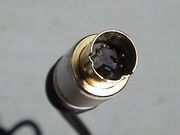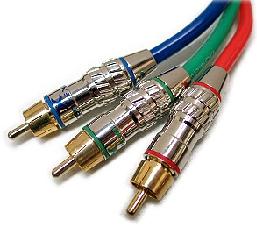Console Recording
From SDA Knowledge Base
Capturing a console run is basically like taping a normal television show. However, SDA has higher standards for run quality than some guy making sure he doesn't miss the latest episode of Survivor. In order to make sure your video quality is the best it can be, it's important to be careful.
Video Cables
The first step in the video's journey from console to our servers is the audio out cable. There are generally two cables you plug into your console; the power cord, and the audio out cable. There are now FOUR different kinds of audio out cables that consoles can use, and choosing the best one can have a dramatic effect on your video quality.
Note that you really need two cables here: one from your console to your VCR or DVD recorder, and one from that to your TV. It doesn't actually matter what the second plug is as far as your run quality goes, since that cable is only so that you can see what the heck you're doing on the TV screen. Obviously, it might be nice for you to have a good quality cable here too for your own sake, even when you're not speedrunning, but it's not nearly as crucial.
In order, from worst to best, they are:
RF
An RF cable ends in a box with a cord sticking out. You plug the cord sticking out into the back of your TV, where you would normally plug in your cable TV hookup. To continue watching cable TV, you would also plug the cable TV hookup into the box. Games are displayed in place of channel 3 or 4 whenever the console is turned on.
RF is an ancient, ancient technology. It is pretty much worthless, and will shoot your run quality to hell. Do not use it if at all possible. Very few systems offer only RF output. The ones known by the authors are:
- NES II (A late-model redesign released in the final days of the NES and is easily identifiable by its top-loading cartridge slot and SNES-style controllers.)
- Sega Master System II (A cheaper version of the Sega Master System which cut several features to lower the price such as the card slot, expansion port, composite output and the reset button.)
For the SMS II, there's still hope if you feel like cracking open your console: SMS II RGB Mod
Adding better video output to an old console is acceptable to SDA: What nate had to say
Composite
A composite cable ends in three colored plugs - a yellow one, a red one, and a white one. These are plugged into three color coded ports on the back of your VCR or DVD recorder. The yellow plug carries the video signal, while the red and white plugs carry the left and right audio signals.
While not nearly as horrible as RF, composite video is still fairly lame next to S-Video. However, since S-Video is a newer technology, not all earlier consoles support it. More details in the next section.
S-Video
The S-Video cable looks very much like a composite cable. However, in addition to the three colored plugs, there is also one, much larger metal plug. This plug is the S-Video plug, which carries what was once the best video signal available. The audio is still transmitted over the red and white cables.
Note that BOTH the yellow plug and S-Video plug carry the video signal. Only the S-Video plug carries the superior quality signal; the yellow plug carries a composite signal so that the cable can work with older TVs. If both are plugged in, the S-Video signal will be shown. (It's quite instructive to plug all of them in, and then take out and put in the S-Video plug. It's a side by side comparison!) Note that, depending on how your cable is made, you might be able to plug the S-Video and composite cables into two different appliances and have both recieve a signal.
The Gamecube, PS2, XBOX, and Dreamcast all support S-Video, as will all consoles newer than those. In addition, thanks to the fact that Nintendo has used the same AV port for a decade, the SNES and Nintendo 64 can use S-Video cables designed for the Gamecube. The Wii port has broken the trend; more on that later.
PS1 and PS2 S-Video cables are compatible with each other as well. Finally, the Sega Saturn also has support for S-Video. Other consoles do NOT have S-Video cables; therefore, composite cables offer the best quality available for these systems.
The Wii currently does not have an official S-Video cable in American stores. It has component cables and composite cables, but not S-Video. There are third party S-Video cables out there, and you might be able to import S-Video cables.
Also, older VCRs may not support S-Video either, although remember that S-Video cables are backwards compatible on the receiving end. Still, you won't get S-Video quality unless you have a true S-Video port.
Component
This section really needs somebody who knows what the heck they're talking about to flesh it out, since I don't know 1080i from my right elbow. Still, what I have put should be entirely valid. I would appreciate extra effort to make sure all the new consoles get love here, too, especially when it comes to 360 and PS3 cable compatibility and such, since I sure am not going to be able to provide it myself.
Component is the newest and best kind of video cable on the market. Unlike S-Video, it can not be plugged into an older input jack, even at a loss of quality. Only the best of the best VCRs have component-in jacks, if any of them even do, but at that point you're probably spending enough money that you could (and should!) go out and buy a DVD recorder for the same price instead.
Component cables are supported by all three of the so-called next gen consoles (the 360, PS3, and Wii). An interesting issue is the GameCube, however. It is possible to use component cables with the GameCube, but there are two major problems. First of all, the official cables were discontinued, long before the Wii in fact. Second of all, the actual port on the GameCube to plug the component cables in is only present on early batches of GameCubes. Later models had the port removed in a cost-saving measure, since very few people used them anyway. If you have two video plugs on the back of your 'cube, you have the early model. The second port will in fact be labeled "Digital Out" or something like that. (This also means that this particular cable can't be used on the N64 or SNES either.)
Recording Medium
There are two mediums you can record to: VHS and DVD. DVD is far superior to VHS, but costs more at this time. While it's recommended that you dish out the extra cash if you can, VHS runs are still accepted for the moment. For a more detailed discussion and the next steps for you to take, read the VHS and DVD sections.


